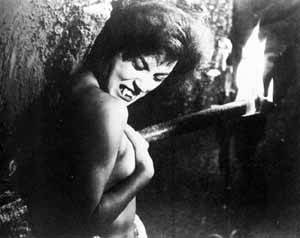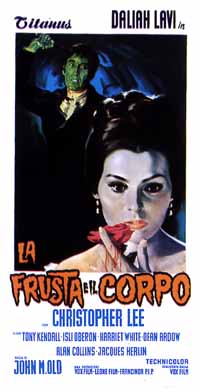|

Maria Giovanni gets staked in
The Vampire and the Playgirls.
By the late '60s, however, Italian gothic horror desperately needed some new blood. Many of the situations had long become cliché. All too frequently travelers became stranded at isolated castles. All too frequently duplicitous lovers plotted murder against a wealthy husband. And all too often mad doctors searched for blood in order to restore a dead wife or daughter.
As the political climate in Italy changed in the late '60s, filmmakers found greater freedom and less censorship. As a result, filmmakers focused more upon blood and gore and less upon atmosphere. The gothic horror movie started to disappear, dwindling to a trickle in the '70s. In their place, a new tradition developed, embodied by masked killers and overworked detectives. Dario Argento showed a path to the future with his giallo-thriller The Bird with Crystal Plumage, and many other mysteriously-titled movies followed in its wake, such as Lucio Fulci's A Lizard in a Woman's Skin. Even Riccardo Freda succumbed to the changing tastes and created his own murder mystery, The Iguana with the Tongue of Fire, as did Mario Bava with Five Dolls for an August Moon and Ecology of a Crime. (The grisly murders in the latter film would be closely imitated in Friday the 13th.)
As the decade wore on, masked murderers turned into zombies and cannibals in films such as Lucio Fulci's Zombi 2 and Ruggero Deodato's Cannibal Holocaust, while Mario Bava's son, Lamberto, contributed his own charnel house of horror, Demons in 1980.
By this time, gothic horror cinema, as it existed in the early '60s, was long gone. Whereas some genres thrive on the familiarity of their plots and their character types (as in the Western, for example), horror relies on surprises, and over familiarity tends to crush the thrills. But thanks to home video, most of these movies are now available again. Unfortunately, most of the prints are in sad condition, making watching these films a test of faith.

Italian poster artwork for What
courtesy of Dean Harris and Silent Scream.
For example, I can only trust Phil Hardy's observations in The Encyclopedia of Horror Movies when he claims that Nevenka (Daliah Lavi) is the mistress of her husband's father in Mario Bava's What. This part of the story is completely absent from the American print of the movie, and without this information, the father's death makes little sense. But when we see that the same knife was used to kill Nevenka's two lovers--as well as herself--the story gains an extra resonance and purpose. (Many TV prints are also missing all of the movie's sadomasochistic whipping scenes, which has the effect of rendering the movie completely incomprehensible.) That's part of the frustration and the attraction of Italian cinema as you can always wonder if a specific movie might suddenly make complete sense if a certain deleted sequence or mistranslated piece of dialog were restored. But the faith is really in the images themselves--as in Black Sunday when a crypt explodes to reveal the heaving body of the revived witch Asa, quickly coming back to life; as in The Horrible Dr. Hichcock when we see the distorted mask of Dr. Hichcock as he descends on his helpless wife Cynthia; as in Castle of Blood when we see the tangle of bloodied bodies around the bed of Elizabeth. These magnificent images--some of the most powerful images in the history of horror cinema--are enough to give their fans a religious-like faith in the genre.
page 2 of 2
 
Italian Horror Menu page
Italian Horror: A Brief Introduction
Mario Bava: The Illusion of Reality
Mario Bava's Rabid Dogs
Mario Bava Biography
The Horrible Dr. Hichcock
The Devil's Commandment 
Castle of Blood 
Nightmare Castle
The Bloody Pit of Horror 
Italian Horror in the Seventies
Suspiria
Italian Horror Web Links
Photo credits: Silent Scream and Sinister Cinema
| 



